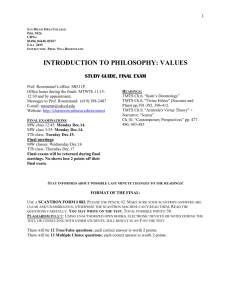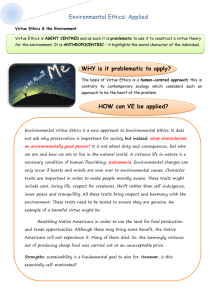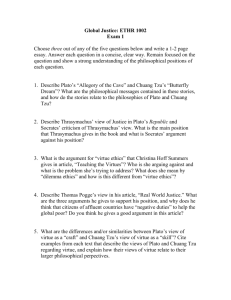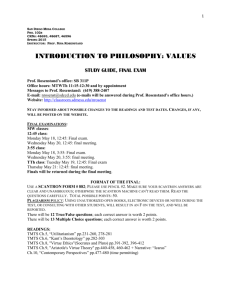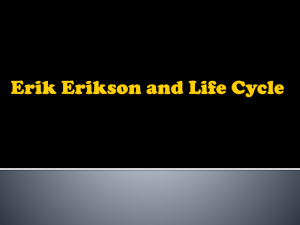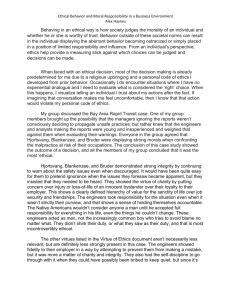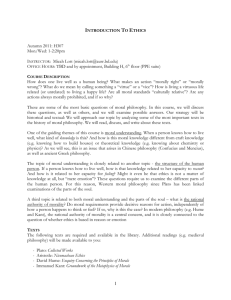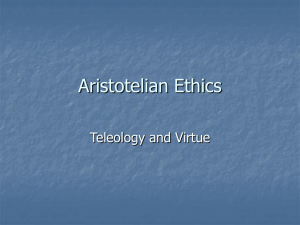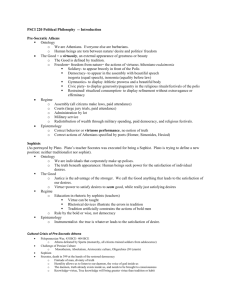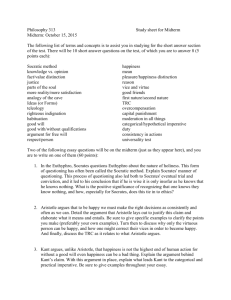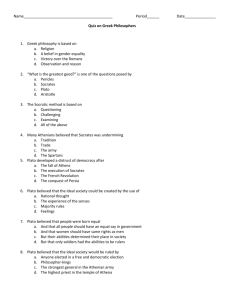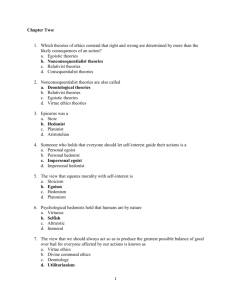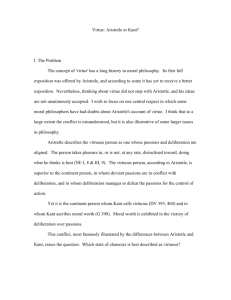final study guide - San Diego Mesa College
advertisement
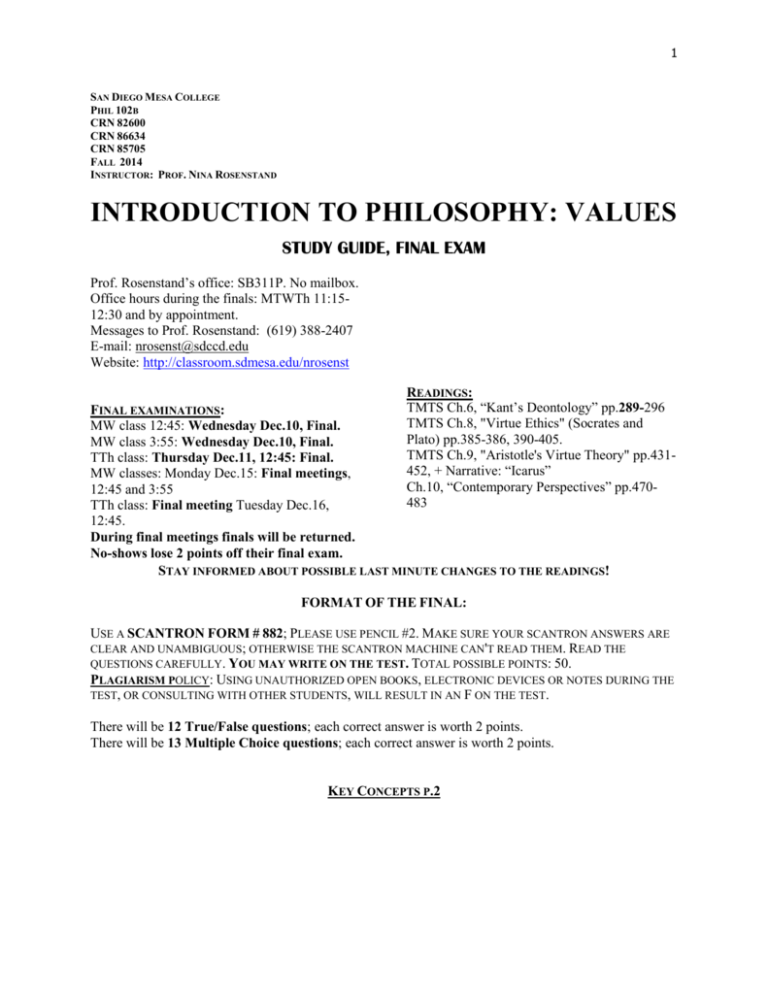
1 SAN DIEGO MESA COLLEGE PHIL 102B CRN 82600 CRN 86634 CRN 85705 FALL 2014 INSTRUCTOR: PROF. NINA ROSENSTAND INTRODUCTION TO PHILOSOPHY: VALUES STUDY GUIDE, FINAL EXAM Prof. Rosenstand’s office: SB311P. No mailbox. Office hours during the finals: MTWTh 11:1512:30 and by appointment. Messages to Prof. Rosenstand: (619) 388-2407 E-mail: nrosenst@sdccd.edu Website: http://classroom.sdmesa.edu/nrosenst READINGS: TMTS Ch.6, “Kant’s Deontology” pp.289-296 FINAL EXAMINATIONS: TMTS Ch.8, "Virtue Ethics" (Socrates and MW class 12:45: Wednesday Dec.10, Final. Plato) pp.385-386, 390-405. MW class 3:55: Wednesday Dec.10, Final. TMTS Ch.9, "Aristotle's Virtue Theory" pp.431TTh class: Thursday Dec.11, 12:45: Final. 452, + Narrative: “Icarus” MW classes: Monday Dec.15: Final meetings, Ch.10, “Contemporary Perspectives” pp.47012:45 and 3:55 483 TTh class: Final meeting Tuesday Dec.16, 12:45. During final meetings finals will be returned. No-shows lose 2 points off their final exam. STAY INFORMED ABOUT POSSIBLE LAST MINUTE CHANGES TO THE READINGS! FORMAT OF THE FINAL: USE A SCANTRON FORM # 882; PLEASE USE PENCIL #2. MAKE SURE YOUR SCANTRON ANSWERS ARE CLEAR AND UNAMBIGUOUS; OTHERWISE THE SCANTRON MACHINE CAN'T READ THEM. READ THE QUESTIONS CAREFULLY. YOU MAY WRITE ON THE TEST. TOTAL POSSIBLE POINTS: 50. PLAGIARISM POLICY: USING UNAUTHORIZED OPEN BOOKS, ELECTRONIC DEVICES OR NOTES DURING THE TEST, OR CONSULTING WITH OTHER STUDENTS, WILL RESULT IN AN F ON THE TEST. There will be 12 True/False questions; each correct answer is worth 2 points. There will be 13 Multiple Choice questions; each correct answer is worth 2 points. KEY CONCEPTS P.2 2 Key Concepts Ch.6 Recap (will not be on test): Kant’s categorical imperative: Absolute moral command Structure of cat.imp.: State your maxim, universalize it, ask if it is rational. 5 critiques of the cat.imp.: 1) Mill: Kant is referring to consequences; 2) cat.imp. doesn’t solve conflict between duties; 3) the loophole, making the maxim too specific; 4) What is rationality? Depends on goal; 5) Cat.imp. allows for no exceptions (example: the killer at the door) Intrinsic value vs. instrumental value Kant: rational beings should be treated as “ends-inthemselves” with intrinsic value “ends in themselves”: respect for rational beings including yourself “Merely a means to an end” = instrumental value only (taking advantage of others) “means to an end” is not the same as “merely a means to an end” (use vs. abuse, disrespect) Rational persons vs. non-rational things/animals Problems: what about humans who are not rational, and animals Kant regarded animals as things Kant’s last book: invented hybrid concept in-between “person” and “thing,” for humans. Not for animals. But Kant was against animal experiments. Kingdom of Ends: Kant’s utopia, using cat. imp. and treating people with respect Ch.8 ethics of conduct (what to do?) vs. virtue ethics (how to be?) Christianity (God gets credit for good character) eliminated ancient virtue ethics (you take credit for creating your own good character) virtue (arete: excellence) Hypatia: murdered woman philosopher The charges against Socrates: offending gods, corrupting youth Socrates’ final words: owing a rooster to Asclepius Socratic method (dialectic method) opinion (doxa) vs. knowledge (episteme) Socrates: People do morally wrong acts out of ignorance Socrates’ 3 parts of the psyche: reason, willpower, appetites (desires) 3 corresponding virtues: wisdom, courage, temperance Freud’s three parts of the psyche, inspired by Plato’s Republic: id, ego, superego Plato opens up the first adult school, the Academy Plato’s three sections of the ideal state: philosopherkings, police & military, and the general population Women’s place in the ideal state determined by talent, not gender. So: women in gov’t, and military. Plato’s influence on Christianity through St. Augustine: The life of the soul is more important than the life of the body [from your notes] Primary Reading: The Republic: the virtue of reason corresponds to wisdom, the “spirited part” (willpower) corresponds to courage, and controlled appetites correspond to temperance. The combined virtue is justice. Ch.9 Aristotle had ambitions to take over Plato’s school, but never succeeded. He opened up his own school, the Lyceum. Aristotle's theory of four causes: material, efficient, formal, final teleology: theory of purpose teleological explanation vs. causal explanation (“giraffes”) the Golden Mean= relative mean between extremes of excess and deficiency examples of virtues (courage, pride, anger, etc.) happiness (eudaimonia) is the reward of virtue Aristotle had enormous influence on Western and Middle Eastern thinking. Problems with ancient virtue ethics: undemocratic; can’t solve difference of opinion. Narrative: “The Flight of Icarus”: the Golden Mean: not too high, not too low Ch.10 The late 20th century revival of virtue ethics Negative role models teach good lessons Kant did not approve of role models The political aspect of conduct vs. character Mayo: becoming virtuous by having role models; works better than ethics of conduct 3 problems with Mayo’s theory: (1) What if people can’t agree on role models? (2) What if one’s role model is imperfect? (3) Can we be virtuous by just emulating role models? Foot: Reintroduced virtue ethics. Virtue is a matter of good intentions, not just a good disposition
